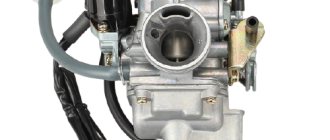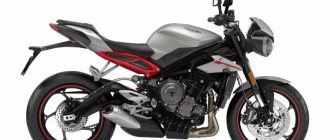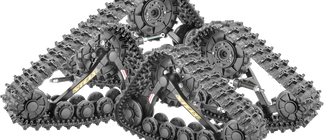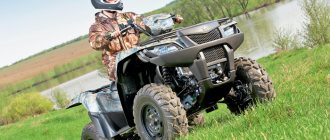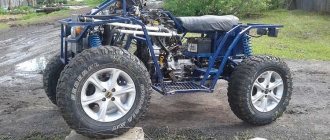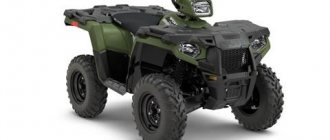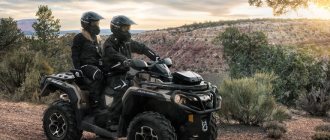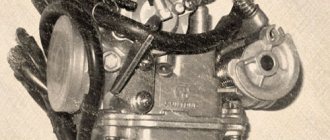- What is an ATV
- The structure of an ATV and the principle of its operation
- Features of BRP ATVs
- Types of ATVs
- Choosing an ATV for different operating conditions
- ATVs for beginners
- Criteria for selecting supported ATVs
- Infographics
All types of transport, except special equipment, can be divided into two large groups: road and off-road.
This applies to both cars and motorcycles. The difference between them is colossal, since some are created for movement on smooth asphalt roads, others are designed for operation in partial or complete off-road conditions with all the ensuing consequences. A popular off-road vehicle today is the ATV. Soggy mud, sandstones, clay, bumps, potholes and various types of unevenness are suitable conditions for riding an ATV. The growing demand for four-wheeled off-road motorcycles is explained by increased cross-country ability, ease of use, fuel economy and relatively inexpensive maintenance.
What is an ATV
An ATV is a four-wheeled vehicle belonging to the class of motor vehicles, designed for driving over rough terrain in partial or complete off-road conditions, but can also travel on dirt and asphalt roads. It has increased cross-country ability, is equipped with an engine with increased power and a predominantly automatic transmission (variator), less often a manual one.
In Western countries, the abbreviation “ATV” is added to the name of the ATV, which stands for “All Terrain Vehicle” (vehicle for all types of surface) or SSV - “Side-by-side Vehicle” (which in correct translation means “moving side by side”) side"). Versatility of operation is one of the main principles underlying the concept of creating off-road vehicles, also called all-terrain vehicles or all-terrain vehicles.
The ATV can also be ridden in the city, but technical parameters, including the engine structure, chassis with independent suspension and four wheels with large treads, indicate that the ATV was originally created for off-road driving. Therefore, buying such equipment for moving in the city is an idea devoid of meaning and logic. Unless we are talking about sports models designed for driving mainly on flat surfaces.
The best work ATVs
These models are designed for heavy-duty work or cargo transportation. Their main features are a spacious trunk, a high-power engine and large-diameter wheels.
Stels ATV 850 Guepard Trophy Pro EPS - a productive unit
4.9
★★★★★
editorial assessment
100%
buyers recommend this product
See review▶
The Stels model is equipped with a four-stroke two-cylinder engine with a displacement of 850 cm³, an automatic clutch and has a ground clearance of 310 mm. The ATV package includes wheel arch extensions, aluminum underbody protection, mud tires, rear and front guards. Good handling is guaranteed by electric power steering, and comfort is ensured by independent suspension with hydraulic shock absorption.
Advantages:
- powerful engine;
- volumetric fuel tank of 30 liters;
- wide wheelbase;
- durable body;
- automatic clutch.
Flaws:
- high price.
Stels Guepard Trophy is universal and can be used both for tourism and for performing the most complex work. The heavy-duty engine and excellent handling ensure not only good performance, but also maximum riding comfort.
Russian Mechanics RM 800 DUO - powerful multifunctional transport
4.8
★★★★★
editorial assessment
95%
buyers recommend this product
See review▶
The distinctive characteristics of this model include large dimensions and a powerful 800 cm³ engine. The weight of the ATV is almost 400 kilograms, the diameter of the wheels is 14 inches.
It is equipped with a tow bar, a winch and a spacious trunk. The fuel tank capacity is 24.5 liters, which ensures continuous operation for a long time. The maximum speed of transport is 100 km/h.
Advantages:
- powerful 60 hp engine;
- wide wheels of large diameter;
- volumetric fuel tank;
- high-quality assembly.
Flaws:
- plastic case.
Russian Mechanics RM 800 DUO can be used for snow removal, cargo transportation and other work. It is adapted to work in any weather and is extremely reliable, although damage to the plastic case (scratches, small cracks) is inevitable.
Yacota Slogger - transformable ATV
4.8
★★★★★
editorial assessment
94%
buyers recommend this product
See review▶
A special feature of the model is its transformable body, which allows you to attach a dump-type body to the rear. This provides a significant increase in the performance of the ATV when transporting cargo.
Large diameter wheels and a powerful engine guarantee long-lasting operation in difficult conditions. Independent double wishbone suspension with hydraulic shock absorbers helps maintain stability when driving in various conditions.
Advantages:
- roomy body;
- body transformation;
- high load capacity;
- good handling;
- low price.
Flaws:
- small fuel tank volume.
Yacota Slogger will be an excellent assistant on a plot of land, a construction site, when transporting goods and other work. Affordable price and versatility make it stand out from its analogues.
The structure of an ATV and the principle of its operation
The technical structure of all-terrain vehicles is standard and understandable to anyone who has at least a little understanding of the internal structure of cars and motorcycles.
- Most models are equipped with four-stroke engines with different capacities - 100 to 1000 cc. see. Depends on the class of equipment and the expected direction of operation. ATVs are equipped with both diesel and gasoline engines, depending on the area of operation of the motorcycle.
- ATVs, due to their operational features, are often equipped with automatic transmissions or CVTs operating in high or low gear positions. However, models are also produced with a manual transmission, but there are fewer of them, since manual gear shifting is impractical when driving off-road.
- The system that transmits torque to the wheels can be cardan or chain. ATVs designed for driving on difficult terrain are equipped with cardan drives, which makes them more reliable, but adds weight to the equipment. Chain drives are installed on sports and universal (utilitarian) all-terrain vehicles.
- Due to the fact that ATV and SSV equipment is designed for operation in difficult, sometimes extreme conditions, it is subject to increased demands on the suspension. Most models are equipped with a suspension system, which consists of two levers, a pendulum suspension on the rear axle, a front shock absorber and a hydraulic shock absorber. Models designed for use in difficult conditions have independent suspension with hydraulics on each wheel.
- The cooling system can be air or liquid. The air system is easier to maintain and copes with the engine cooling function at medium loads. The liquid cooling system is more complex, but also much more efficient.
- The width of the tire and the size of the tread are responsible for the “tight” grip on the surface, the degree of immersion in soft soil and maneuverability. Sports ATVs designed for riding on smooth, hard or asphalt surfaces are usually equipped with tires with light tread. For rough terrain with small differences in surface level, tires with medium tread are suitable. Mud, sand, wet river bank, clay, stones - for such conditions, tires with a large aggressive tread are used.
These are the main components of an ATV, on the basis of which the choice is made in favor of one model or another.
ATV engine speed and rpm
Home → Maintenance → How to determine the correct settings of the ATV carburetor by engine operation.
- Mechanic
- 21.03.2017
- 16723
- 8 comments
- carburetor adjustment
For stable operation of the ATV engine, the carburetor needs to supply the optimal fuel mixture, that is, it must be adjusted correctly, taking into account the rpm range.
We recently wrote an article about setting up an ATV carburetor, and now let's learn how to determine errors in setting up a carburetor based on engine performance.
To configure the ATV carburetor correctly, you need to take into account the ratio of the gas-air mixture in the rev range. For example, an ATV engine has enough fuel at medium speeds, but this does not mean that the situation will be the same at high speeds. Let it be known to you that driving on a lean mixture sooner or later leads to overheating of the engine and jamming of the piston and, as a result, a spoiled mood and expensive repairs.
The ATV carburetor is configured correctly:
- Idle speed is stable (does not float);
- Fuel is consumed within the limits specified by the manufacturer;
- There is no loss of power across different speed ranges;
- There are no pops in the carburetor;
- The ATV confidently accelerates;
- There is no black soot on the spark plug, no signs of melting, and the color of the electrode is light brown.
Signs of a rich mixture at low and medium engine speeds:
- Black candle with velvet soot;
- Floating idle speed;
- Fuel consumption is significantly exceeded (this point is relevant when the starting enrichment is configured).
Signs of a lean mixture at low and medium engine speeds:
- Problems with starting the ATV engine;
- Idle speed fluctuates greatly, and stability is achieved only by increasing it;
- The response to the throttle trigger is sluggish;
- The spark plug electrode is white;
- You can hear popping noises in the carburetor when adding gas.
Signs of a rich mixture at high engine speeds:
- Fuel consumption is significantly increased;
- The speed increases when the gas is reduced from the maximum value;
- There are interruptions in engine operation at high speeds;
- The unburned mixture enters the muffler, causing strong popping noises to be heard in it;
- There is a strong black soot on the candle.
Signs of a lean mixture at high engine speeds:
- Popping sounds in the carburetor at maximum speed;
- There is absolutely no carbon deposits on the spark plug; you can even observe the melting of the electrode;
- Acceleration dynamics are significantly reduced, as is the response to the throttle trigger;
We think that now you can easily adjust the carburetor of your ATV properly, and avoid troubles and repairs.
Source
Advantages of ATVs from the Canadian company BRP
The Canadian company Bombardier Recreational Products (BRP) specializes in the production of snowmobiles and ATVs. In the history of the company, which began in 1942, attempts were made to launch the production of SUVs, but the main direction was the development of modern mobile vehicles designed for atypical operating conditions.
The popularity of BRP off-road equipment is explained by the following criteria:
- high reliability of ATVs, which is confirmed by a long service life;
- exceptional quality of all parts;
- an impressive range of all-terrain vehicles, including various types of equipment: sports, utilitarian and touring;
- all BRP equipment is equipped with modern technological systems;
- The company's design engineers are constantly developing and implementing new concepts and technological solutions, creating mobile vehicles with unique parameters, appearance and technical characteristics.
The main difference between the company and other manufacturers is the desire to create more technologically advanced equipment that differs from others in appearance and technical parameters.
Sportsman Touring 850
The American company Polaris has been developing ATVs for a long time; the main users of the products are extreme sports enthusiasts, fishermen and hunters. The Polaris company is rightfully considered the world leader in the production of off-road motorcycle equipment. With each release of a new model, engineers use new technologies and care about the safety and reliability of equipment. One of the brainchilds of the American manufacturer is the Sportsman Touring 850 two-seater ATV.
A model with a progressive two-cylinder engine in which the fuel supply system is injection. High cross-country ability, a combination of interesting design and high speed - this is all about the Touring 850.
Specifications
The engineers gifted the ATV with a 4-stroke two-cylinder SOHC engine, which translates to “single overhead camshaft.” The working volume of the unit is 850 cm3. At high speeds, after a long trip, the engine is cooled by liquid cooling. Speaking about the gearbox, it is necessary to say the following: automatic transmission PVT H/L/N/R/P. Ideal traction is provided by reliable Maxxis® M9805 tires, the dimensions of which are as follows: front - 26x8-14, rear 26x10-14.
Cast aluminum wheels can withstand the load even when overcoming rocky paths and do not burst. The wheelbase of the ATV is 144.8 cm, and the dry weight of the SUV is 362 kg. That is, thanks to such a mass, the ATV is stable off-road during extreme driving. The clearance, which is 28.5 cm, allows you to easily pass through stumps, stones and other obstacles. To increase the time between refueling, the developers took care of the volume of the fuel tank. On the Sportsman Touring 850 its volume is 19.9 liters. Overall dimensions are as follows: length 2197 mm; width 1209 mm; height 1479 mm.
Design Features
The model has an interesting, rather brutal appearance. The massive front part, which together consists of a trunk, a bump stop and flexible plastic, immediately catches your eye. The front luggage rack is designed for a maximum weight of up to 55 kg. If it so happens that the driver does not notice an obstacle ahead or loses control, the bump stop will take the blow and protect the engine from damage. Also, another trunk is installed at the rear, the maximum load on it is 110 kg. As for safety, the Sportsman is equipped with leg protection and is made of durable plastic.
The engineers did nothing for the hands, meaning protective pads. For a comfortable ride for the passenger, the designers took care of installing a backrest and hand grips. As already mentioned, the model is modern, which is confirmed by the installed digital display, which displays a speedometer, hour meter, fuel level indicator, charging socket (DC) and other functions. The ride is comfortable and smooth thanks to the rear independent suspension and front suspension: the technology is based on double A-arms.
The braking system consists of front and rear disc brakes, as well as a parking brake. In addition to all the specified functions and technical characteristics, it is worth noting the presence of a tow bar for transporting a trailer. Based on this, we can conclude: the Sportsman Touring 850 is not only a vehicle for extreme driving, but also an assistant that performs practical tasks in agriculture.
Types of ATVs
According to modern classification, ATVs are divided into types:
- sports;
- utilitarian;
- tourist.
Each type has a number of unique characteristics, differs in parameters and is designed for different operating conditions.
Sports ATVs
ATVs belonging to the sports class are significantly different from other types. The main emphasis is on engine power, independent suspension and chain drive. Sports ATV and SSV equipment is intended for high-speed driving on asphalt, dirt and other flat surfaces. It easily endures jumps and hard landings, quickly picks up speed, and is often equipped with a manual transmission.
Demand for sport ATVs is average because they do not cope well with difficult terrain and cannot overcome difficult obstacles such as swamps, muddy soil, rock piles and large differences in ground level.
Utilitarian (universal) ATVs
Utilitarian ATVs are the most popular and widespread type of all-terrain vehicle. It is distinguished by increased cross-country ability, greater weight and wider operational capabilities. Often purchased for fishing and hunting trips, for household needs (can be equipped with a towbar and winch), and short-term trips over rough terrain. Powerful, reliable, durable. Considered universal. Typically equipped with an engine capacity of 500 to 1000 cc. cm.
Touring ATVs
Touring ATVs are designed for long trips and travel, so they are equipped with many useful options for comfort. Tourist SSV vehicles often have a roof and several passenger seats. These ATVs are larger in size, have an impressive trunk, and these models have a standard car steering wheel.
Touring models are equipped with powerful engines, all-wheel drive and wide tires for better traction. They differ from other types of ATVs by their rather high cost.
Tips for choosing an ATV. Part 1.
Before choosing an ATV, it is important to determine the purpose of the purchase. This could be recreational riding, hunting or fishing, tourism, housework, as well as extreme riding or sports. The type of ATV, required engine power and other parameters depend on the tasks. We will tell you more about how to choose an ATV.
What parameters to pay attention to
Engine capacity.
For recreational riding and light off-roading, ATVs with an engine capacity of 400-500 cm³ are suitable. To navigate difficult off-road routes, it is advisable to choose a model with a cubic capacity of 600 cm³ or more.
Transmission.
Most ATVs have a CVT transmission. It continuously changes the gear ratio and smoothly accelerates the equipment. Allows you to start safely on climbs, and also reduces the risk of an emergency on descents due to the engine braking system. The absence of jerks when switching increases the service life of the components. To overcome severe off-road conditions, the ATV must have an all-wheel drive transmission with a reduction gear and the ability to lock the differential.
Differential lock.
It is necessary that up to 100% of the torque can be transmitted to the wheel. Helps with hanging out or slipping. Forced locking provides better cross-country ability - you can connect it before overcoming off-road conditions. Electronic locking is activated automatically after the start of slipping.
Engine's type.
An injection engine is more economical, easier to start in cold weather, does not require periodic adjustments to the fuel supply, and is more productive due to the optimal mixture composition. The advantages of the carburetor are its simple design and the ability to self-adjust.
Wheel size.
The larger the ATV wheels, the higher the ground clearance and the larger the contact patch with the surface. This increases cross-country ability. Stock tires can be replaced with another one, but you need to take into account that as the diameter of the wheels increases, the load on the transmission and suspension increases. In addition, fender trimming and other modifications may be required.
Seating places.
There are two types of ATVs with a passenger seat: two-seater and one-and-a-half. Fully double-seaters have an extended wheelbase (from 1440 mm), while one-and-a-half-seaters have a regular wheelbase, like single-seater models. This has security implications. If the second seat is located above or behind the rear axle, the occupant increases the likelihood of the vehicle overturning, especially on inclines. Therefore, for traveling with a group, you need to buy a full-fledged two-seater model.
Which ATV to choose - ATV or SSV
Models with a motorcycle seat and handlebars (ATV) have a shorter wheelbase, which means better cross-country ability. Also, due to their compact dimensions, they need less space to turn around and avoid obstacles. Weight up to 450 kg allows the ATV to sink less into the mud. You can resist the overturning of such an ATV by moving your body weight.
All-terrain vehicle (SSV) vehicles typically have a rugged frame, doors, and roof. The long wheelbase and wide track improve stability and handling at high speed. Due to this, SSVs are safer than conventional ATVs. Also, this equipment has a large load capacity - as a rule, 200-400 kg can be loaded into the body of cargo models.
How to choose an ATV for different operating conditions?
Choosing an ATV is a responsible task, since such equipment must be selected taking into account the expected operating conditions. There is a big difference between equipment for going fishing or hunting and ATVs for sports competitions or performing stunts. Therefore, the choice must be made taking into account the areas of activity.
- ATV for hunting, fishing and household needs. For such types of activities, utilitarian ATVs with universal characteristics are often purchased. Medium-sized tank, all-wheel drive, diesel or gasoline engine with a power of 50 hp or more. (from 500 cc and above), load capacity - about 150 kg, wheel width from 170 mm, ground clearance - 10 cm. Suitable models: OUTLANDERMAX 570 DPS and OUTLANDER MAX 650. You can also pay attention to unique models with a six-wheel base: OUTLANDERMAX 6x6 650 or OUTLANDERMAX 6x6 1000.
- ATV for high-speed driving on flat surfaces and rough terrain with small differences. Models with a gasoline engine with an injector from 800 cc are suitable. cm and above. Suitable models: RENEGADE 1000 RXXC or MAVERICK XRS TURBO.
- ATV for tourists with a penchant for extreme hobbies. Models with the following parameters are suitable: gasoline engine with a volume of 750 cc. cm, full cardan drive with independent suspension, liquid cooling, large tank and load capacity of 250 kg and more. Suitable models: MAVERICK TRAIL 800 DPS and MAVERICK SPORT MAX 1000 DPS.
Which ATV to choose for a beginner
Choosing an ATV/SSV vehicle for a beginner is a responsible process, since the first ATV should not disappoint the owner with either technical parameters or operating characteristics. It is better to choose from the “utilitarian” category, since utilitarian ATVs are more versatile and will help you decide which driving style is preferable.
An ATV for a beginner should have the following characteristics:
- sufficient power reserve (from 50 hp) so that there are no problems with overcoming obstacles;
- independent suspension for a comfortable ride in any conditions;
- automatic transmission or variator;
- medium sized wheels.
Suitable models for beginners: OUTLANDERMAX 570 DPS or OUTLANDERMAX 650 XT.
What is the difference between a utilitarian ATV and a tourist one?
If we talk about the external differences between a utilitarian ATV and a tourist one, we can immediately note the increased size of the wheels with tires with deep tread, a more powerful engine and additional equipment.
Utility ATV
As a rule, a utilitarian all-terrain vehicle is equipped with one or two luggage racks (front and rear), a tow bar and additional equipment (winch, snow plow).
Some models designed for winter use can be equipped with heated grips, a windshield and tracks that turn the utilitarian ATV into a snowmobile.
If tourist all-terrain vehicles are used for off-road travel, then utilitarian vehicles are purchased for use in agriculture, construction, debris removal, and cargo transportation. Their main disadvantage in comparison with tourist models is their higher cost.
A utilitarian ATV is a vehicle that can solve any problems in everyday life, if you live outside the city or spend a lot of time in the country.
Criteria for selecting supported ATVs
Buying used equipment is always a risk, even if the seller is a trustworthy company. Therefore, before purchasing a used ATV, you need to check the performance of all systems and units, paying special attention to:
- the presence of liquid in the cooling system and the integrity of the radiator;
- condition of the suspension, levers and shock absorbers of the chassis;
- degree of tire tread wear;
- transmission performance, especially if the gearbox is manual;
- serviceability of the brake system.
Some systems can be easily checked during inspection, others must be tested in motion, including acceleration, braking, and transmission tests. It is better if the serviceability of the ATV systems is checked by a technician who has the appropriate knowledge and experience.
